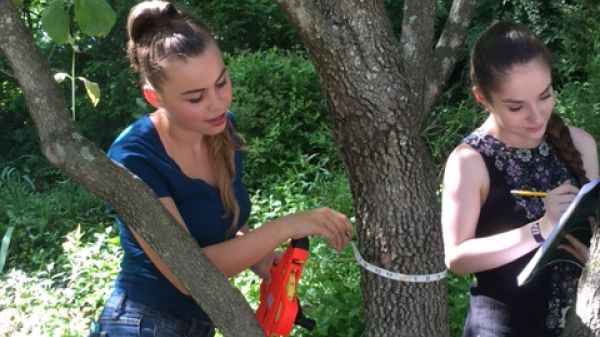PLT’s GreenSchools Takes Root at Marshall High School

Project Learning Tree’s GreenSchools program is a nationwide environmental service-learning program that gives students the tools they need to make their schools, homes, and communities greener and healthier. The leadership, critical thinking, and problem-solving skills that students develop as leaders in the program gives them a strong foundation for a lifetime of environmental stewardship. GreenSchools also helps students gain real-life experience in a variety of environmental fields, including energy and water conservation, landscape architecture, waste management, and environmental quality.
Because of these benefits (and more!), my daughter and I wanted to bring GreenSchools to her high school in Falls Church, VA. We thought it would be easy to get such a great program started, but it took a bit more effort than we thought. Read on to see how we helped GreenSchools take root at Marshall High….
Step 1: We sent an email to the principal introducing the program and asking permission to start it. Weeks went by and we didn’t receive a response (granted there was a bomb threat the day that the email was sent! – so the principal had other more pressing priorities).
Tip #1: Keep in mind that administrators and teachers are typically overwhelmed with commitments and problems to solve!
Step 2: We sent another email to the principal inquiring about our idea. Still no response. So we decided to find a way to introduce the idea in person. Because the principal attends the PTA meetings, we asked to be on the agenda for the next meeting.
At the PTA meeting, we gave a brief presentation (showing the PLT Welcome to GreenSchools! video on YouTube). There was overwhelming interest. The principal then arranged a meeting with all the potential stakeholders, including the school district environmental coordinator and the school’s environmental science teachers.
Step 3. At the first meeting with stakeholders, we received permission to start the program! A retired environmental science teacher was at the meeting and she agreed to be the school sponsor for GreenSchools and offered to help get things going. She was already the head of the school’s Earth Force Club and thought this would be a natural fit with this club. In addition, the district environmental coordinator felt that GreenSchools would be a good fit with other green initiatives already underway at schools throughout the county. These other initiatives include the district’s Get2Green program and the Green Schools Alliance.
Furthermore, the IB environmental science teachers felt that the GreenSchool Investigations would give students ideas for class investigations, science fair projects, service opportunities, and IB essays. They were so impressed with the program and its potential that they both registered for the online GreenSchools professional development training.
Tip #2: Keep your PLT state coordinator in the loop. They can provide materials, resources, and local experts to help with the GreenSchools Investigations and professional development workshops.
Step 4. We held a kickoff meeting for all interested students and teachers during study hall. The meeting was advertised through an email to teachers and text messages to members of the school’s Earth Force Club, Envirothon group, National Science Honor Society, and the Key Club. It was also advertised through posters placed throughout the school. Members from all the clubs were represented at the meeting and they all agreed that they wanted to participate in GreenSchools! In addition, other interested students and teachers attended.
Tip #3: Provide snacks at meetings and get students’ cell phone numbers. Students pay more attention to and respond faster to text messages than emails.
At the meeting, we circulated a sign-up sheet so we could gather contact information: email addresses, cell phone numbers, and availability for meetings. We showed the Welcome to GreenSchools! Video and demonstrated how scientific tools could be used to help students complete the investigations, including CO2 monitors, infrared temperature thermometers, and light meters. Oh, and we provided snacks!
We were officially on our way with more than 25 interested students signed up to be on the Green Team!
Tip #4: Find out if your school district has engaged an environmental auditor or energy consultant. If so, they should have detailed energy use data and may be willing to provide a behind-the-scenes tour of the school’s energy facilities.
Step 5: Our next steps include:
Assigning specific tasks to Green Team members
Gathering the necessary equipment and documents for each investigation;
Contacting school personnel that we would like to assist with the investigations; and
Scheduling when we will conduct each investigation.
Green Team members also discussed how to involve other clubs and classes in GreenSchools. For example, the marketing club could develop a social media campaign to spread the word about ways to save energy, the economics club could help analyzing data and potential cost savings, and the computer science club could create a system to record collected data.
Tip #5: There’s nothing like a little high school competition to rally student involvement. Challenge a nearby high school to compete with your school to see who can save the most energy in 6 months!
Stayed tuned for part 2 of this blog when we’ll discuss the Green Team’s progress!
By Sheri Soyka
(Sheri is a consultant serving the needs of environmental education organizations nationwide. Her daughter, LeeAnn Soyka and Dana Dannhardt, featured in the above picture are Marshall HS Green Team leaders.)
